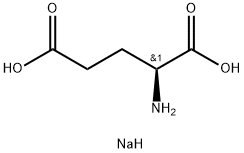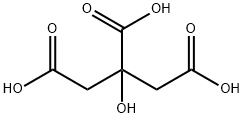L-GlutamicAcidMonosodium , 95% , 142-47-2
CAS NO.:142-47-2
Empirical Formula: C5H10NNaO4
Molecular Weight: 171.13
MDL number: MFCD00013074
EINECS: 205-538-1
| Pack Size | Price | Stock | Quantity |
| 100g | RMB24.00 | In Stock |
|
| 500g | RMB59.20 | In Stock |
|
| 1000g | RMB107.20 | In Stock |
|
| others | Enquire |
PRODUCT Properties
| Melting point: | 232°C |
| alpha | 20 -3.5° (10% soln in 5° Bé HCl); D20 +25.16° (10g MSG/100ml 2N HCl) |
| Density | d20 (saturated water soln): 1.620 |
| refractive index | 25 ° (C=10, 2mol/L HCl) |
| FEMA | 2756 | MONOSODIUM GLUTAMATE |
| storage temp. | Keep in dark place,Inert atmosphere,Room temperature |
| solubility | Soluble in water; sparingly soluble in ethanol (95%). |
| form | powder |
| color | white to off-white |
| Odor | Odorless |
| biological source | synthetic |
| Water Solubility | >=10 g/100 mL at 20 ºC |
| Merck | 6254 |
| Stability: | Hygroscopic |
| Cosmetics Ingredients Functions | FRAGRANCE SKIN CONDITIONING HAIR CONDITIONING |
| LogP | -1.44 |
| CAS DataBase Reference | 142-47-2(CAS DataBase Reference) |
| EPA Substance Registry System | Monosodium glutamate (142-47-2) |
Description and Uses
History of development. The best known and most widely used flavor enhancer is monosodium glutamate (MSG). In 1866, a German chemist, Ritthausen, isolated glutamic acid. Later, another chemist converted the acid to a sodium salt, monosodium glutamate. In doing their work, neither had any interest in flavor.
More than 40 years later, in 1908, a Japanese chemist at the University of Tokyo, Dr. Kikunae Ikeda, discovered the flavor enhancing properties of MSG. Dr. Ikeda had set out to find out why and how a certain seaweed, Laminaria japonica, affected flavor. Japanese cooks had used this seaweed for centuries to improve the flavor of soups and certain other foods. Dr. Ikeda discovered that the ingredient in the seaweed that made the difference was MSG, and that it had an unusual ability to enhance or intensify the flavor of many high protein foods.
After isolating MSG, Dr. Ikeda developed a process for extracting it from wheat flour and other flours. Working with the Japanese chemical company, Suzuki and Co., he supervised the construction of a plant and, as a partner with the company, began commercial production of MSG in 1909.
There were several attempts to produce MSG in the United States in the years following, but it was not until the 1940s that large- scale MSG production began in this country. By 1968, U.S. production had grown to 46 million pounds per year. The latest production figures (1987) reported 18.6 million pounds per year.
Flavor and enhancing properties. At one time, it was felt that MSG had a somewhat meaty flavor and that this flavor was a factor in its ability to intensify the flavors of other foods, particularly protein-rich foods. It was discovered, however, that the meaty taste came rather from contaminants in the crude glutamate, and when these contaminants were sharply reduced, the flavor characteristic also was reduced considerably.
MSG is not flavorless. In large enough concentrations, or by itself, it has been found to have a taste of its own, sometimes described as sweet-saline. There are some, in fact, who feel that MSG is nothing more than a seasoner which gains its effect by combining with and intensifying the flavors of the foods to which it is added. However, to say that MSG only intensifies the flavor of foods is too simplistic. When monosodium glutamate is added to food, several specific flavor characteristics are enhanced - such as impact, body or fullness, continuity, mouth fullness, mildness, and complexity. Glutamate also harmonizes the wide range of flavors present in sauces, soups and casseroles, promoting a highly blended and full-bodied perception of flavor.
The savory taste of glutamate is to tomatoes, cheese, and meat what sweetness is to sugar, sourness is to lemons, saltiness is to anchovies and bitterness is to coffee. Just as each of these foods has a distinctive taste, food high in glutamate has a basic and independent taste. In China and Japan, there is a concept for this independent taste, which they call Xian-Wei (China) and Umami (Japan). Current research has found more than 40 umami substances of which glutamate is most common. In fact, umami is an integral part of cuisines throughout the world and has been described by Westerners as “savory,” “broth-like” and “meaty.”.
Production. MSG is commonly produced using a fermentation process using a glucose (often sugar molasses) as a starting substance. Once the glucose is converted to glutamic acid, the glutamic acid is filtered, dissolved and converted to monosodium glutamate by neutralization with sodium hydroxide. The monosodium glutamate solution is decolorized. Monosodium glutamate is then crystallized, dried, sieved, packed and shipped.
MSG is used as a food additive, mainly in oriental cuisine, to enhance and impart a meaty flavor.
Safety
| Symbol(GHS) |  GHS07 |
| Signal word | Warning |
| Hazard statements | H302-H315-H319-H335 |
| Precautionary statements | P261-P301+P312-P302+P352-P304+P340-P305+P351+P338 |
| Risk Statements | 20/21/22 |
| WGK Germany | 2 |
| RTECS | MA1578000 |
| TSCA | Yes |
| HS Code | 29224999 |
| Hazardous Substances Data | 142-47-2(Hazardous Substances Data) |
| Toxicity | LD50 i.g. in mice: 19.9 g/kg (Eka) |


